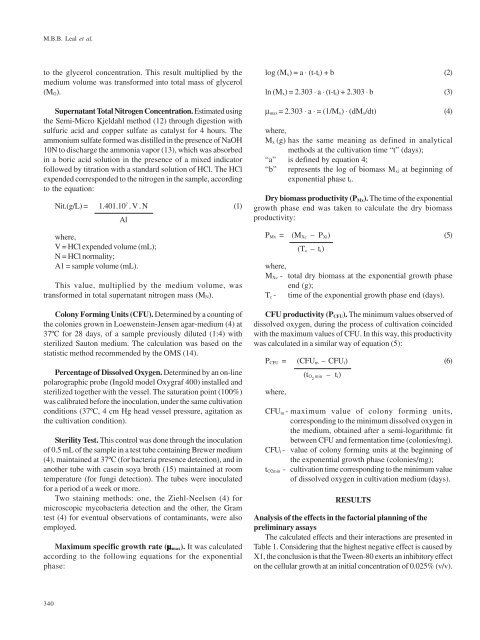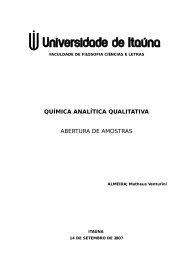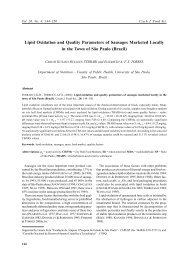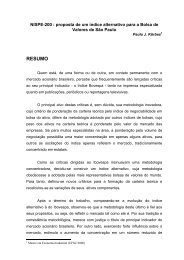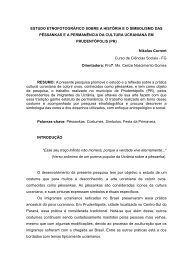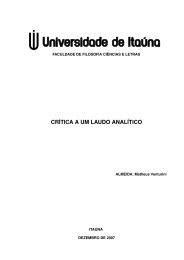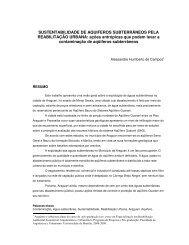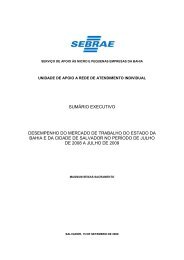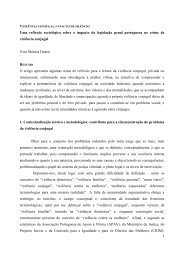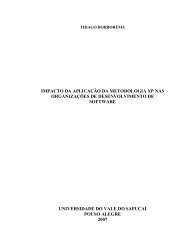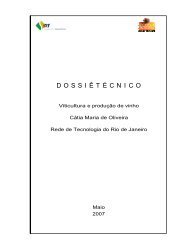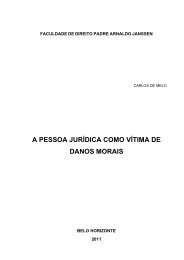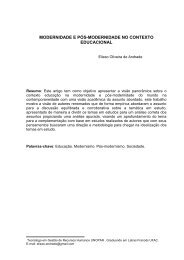MAL 007
MAL 007
MAL 007
You also want an ePaper? Increase the reach of your titles
YUMPU automatically turns print PDFs into web optimized ePapers that Google loves.
M.B.B. Leal et al.<br />
to the glycerol concentration. This result multiplied by the<br />
medium volume was transformed into total mass of glycerol<br />
(MG).<br />
Supernatant Total Nitrogen Concentration. Estimated using<br />
the Semi-Micro Kjeldahl method (12) through digestion with<br />
sulfuric acid and copper sulfate as catalyst for 4 hours. The<br />
ammonium sulfate formed was distilled in the presence of NaOH<br />
10N to discharge the ammonia vapor (13), which was absorbed<br />
in a boric acid solution in the presence of a mixed indicator<br />
followed by titration with a standard solution of HCl. The HCl<br />
expended corresponded to the nitrogen in the sample, according<br />
to the equation:<br />
340<br />
Nit.(g/L) = 1.401.107 . V . N<br />
Al<br />
(1)<br />
where,<br />
V = HCl expended volume (mL);<br />
N = HCl normality;<br />
A1 = sample volume (mL).<br />
This value, multiplied by the medium volume, was<br />
transformed in total supernatant nitrogen mass (MN).<br />
Colony Forming Units (CFU). Determined by a counting of<br />
the colonies grown in Loewenstein-Jensen agar-medium (4) at<br />
37ºC for 28 days, of a sample previously diluted (1:4) with<br />
sterilized Sauton medium. The calculation was based on the<br />
statistic method recommended by the OMS (14).<br />
Percentage of Dissolved Oxygen. Determined by an on-line<br />
polarographic probe (Ingold model Oxygraf 400) installed and<br />
sterilized together with the vessel. The saturation point (100%)<br />
was calibrated before the inoculation, under the same cultivation<br />
conditions (37ºC, 4 cm Hg head vessel pressure, agitation as<br />
the cultivation condition).<br />
Sterility Test. This control was done through the inoculation<br />
of 0.5 mL of the sample in a test tube containing Brewer medium<br />
(4), maintained at 37ºC (for bacteria presence detection), and in<br />
another tube with casein soya broth (15) maintained at room<br />
temperature (for fungi detection). The tubes were inoculated<br />
for a period of a week or more.<br />
Two staining methods: one, the Ziehl-Neelsen (4) for<br />
microscopic mycobacteria detection and the other, the Gram<br />
test (4) for eventual observations of contaminants, were also<br />
employed.<br />
Maximum specific growth rate (µmax). It was calculated<br />
according to the following equations for the exponential<br />
phase:<br />
log (Mx) = a ⋅ (t-ti) + b (2)<br />
ln (Mx) = 2.303 ⋅ a ⋅ (t-ti) + 2.303 ⋅ b (3)<br />
µmax = 2.303 ⋅ a ⋅ = (1/Mx) ⋅ (dMx/dt) (4)<br />
where,<br />
Mx (g) has the same meaning as defined in analytical<br />
methods at the cultivation time “t” (days);<br />
“a” is defined by equation 4;<br />
“b” represents the log of biomass Mxi at beginning of<br />
exponential phase ti.<br />
Dry biomass productivity (PMx). The time of the exponential<br />
growth phase end was taken to calculate the dry biomass<br />
productivity:<br />
PMx = (MXc – PXi)<br />
(Tc – ti)<br />
(5)<br />
where,<br />
MXc - total dry biomass at the exponential growth phase<br />
end (g);<br />
Tc - time of the exponential growth phase end (days).<br />
CFU productivity (PCFU). The minimum values observed of<br />
dissolved oxygen, during the process of cultivation coincided<br />
with the maximum values of CFU. In this way, this productivity<br />
was calculated in a similar way of equation (5):<br />
PCFU = (CFUm – CFUi)<br />
(tO min – ti)<br />
2<br />
(6)<br />
where,<br />
CFUm - maximum value of colony forming units,<br />
corresponding to the minimum dissolved oxygen in<br />
the medium, obtained after a semi-logarithmic fit<br />
between CFU and fermentation time (colonies/mg).<br />
CFUi - value of colony forming units at the beginning of<br />
the exponential growth phase (colonies/mg);<br />
tO2min - cultivation time corresponding to the minimum value<br />
of dissolved oxygen in cultivation medium (days).<br />
RESULTS<br />
Analysis of the effects in the factorial planning of the<br />
preliminary assays<br />
The calculated effects and their interactions are presented in<br />
Table 1. Considering that the highest negative effect is caused by<br />
X1, the conclusion is that the Tween-80 exerts an inhibitory effect<br />
on the cellular growth at an initial concentration of 0.025% (v/v).


